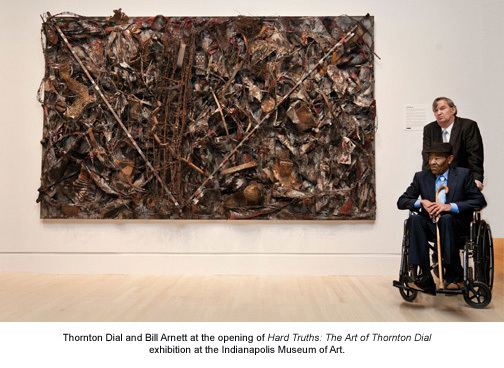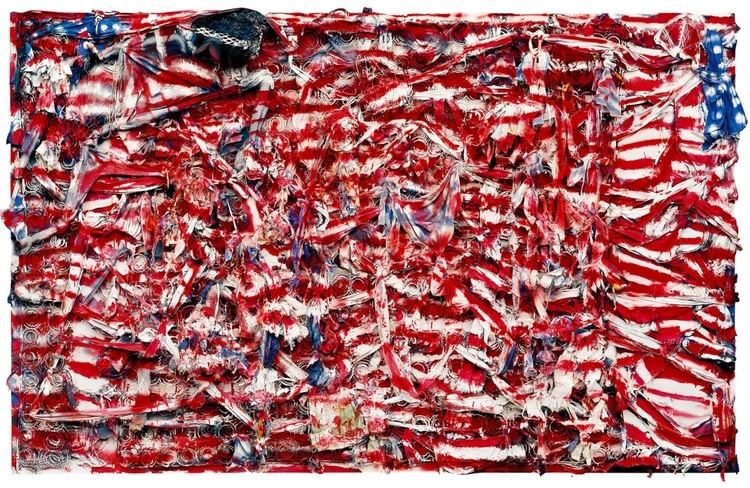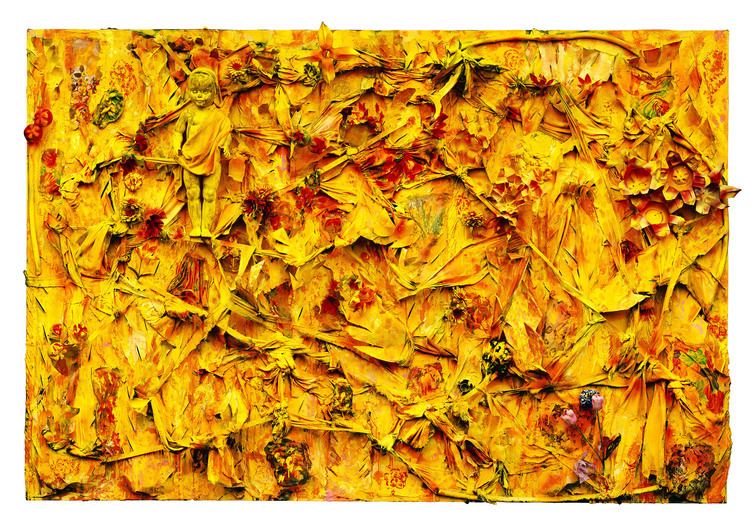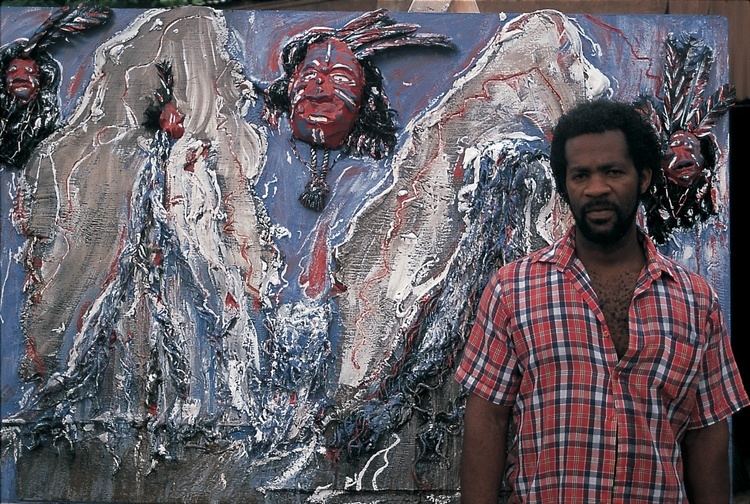Name Thornton Dial Siblings Arthur Dial Books Thornton Dial | Parents Mattie Bell Role Artist Ex-spouse Clara Mae Murrow | |
 | ||
Joanne cubbs outside in the art of thornton dial
Thornton Dial (10 September 1928 – 25 January 2016) was a pioneering African-American artist who came to prominence in the late 1980s. Dial’s body of work exhibits formal variety through expressive, densely composed assemblages of found materials, often executed on a monumental scale. His range of subjects embraces a broad sweep of history, from human rights to natural disasters and current events. His works have been acquired by the Museum of Modern Art, the Whitney Museum of American Art, the Smithsonian American Art Museum, the American Folk Art Museum, and the High Museum of Art in Atlanta, Georgia. Ten of Mr. Dial’s works were acquired by the Metropolitan Museum of Art in 2014.
Contents
- Joanne cubbs outside in the art of thornton dial
- Thornton dial
- Biography
- Dial and Arnett
- Work
- Personal
- Exhibitions
- Museums
- Gallery
- Public collections
- Public art
- References

Thornton dial
Biography

Thornton Dial was born in 1928 to a teen-age mother, Mattie Bell, on a former cotton plantation in Emelle, Alabama, where relatives in his extended family worked as sharecroppers. He lived with his mother until he was around three when Dial and his half-brother Arthur moved in with their second cousin, Buddy Jake Dial, who was a farmer. When Thornton moved in with Buddy Jake, he farmed and learned about the sculptures that Buddy Jake made from items lying around the yard, an experience that greatly influenced him. Dial grew up in poverty and without the presence of his father.

In 1940, when he was twelve, Dial moved to Bessemer, Alabama. When he arrived in Bessemer, he noticed the art along the way in people's yard and was amazed at the level of craft exhibited. He married Clara Mae Murrow in 1951. They have five children, one of which died of cerebral palsy. The late artist Ronald Lockett was his cousin.

His principal place of employment was as a metalworker at the Pullman Standard Plant in Bessemer, Alabama, which made railroad cars. The plant closed its doors in 1981. After the Pullman factory shut down, Dial began to dedicate himself to his art for his own pleasure. In 1987, he was introduced to Bill Arnett, a local art collector of great influence who brought Dial's work to public attention.

Dial lived, worked, and created art in Alabama for his entire life.
Dial and Arnett

Thornton Dial met another self-taught artist Lonnie Holley, who introduced Dial to Atlanta collector and art historian William Arnett. Arnett, whose art historical interests had now focused on African-American vernacular art and artists, brought Dial's work to national prominence. The art historian has also brought Lonnie Holley, the Gee's Bend Quilters and many others to the attention of the United States. Arnett, with Jane Fonda also helped to create a publishing company, in 1996, along with his sons Paul and Matt. He is also the founder and Chairman Emeritus of the Souls Grown Deep Foundation, an organization dedicated to the preservation and documentation of African American art from the Deep South that works in coordination with leading museums and scholars to produce groundbreaking exhibitions and publications using its extensive holdings.
Work
Dial's work addresses urgent issues in the realm of history and politics in the United States, such as war, racism, bigotry and homelessness. He constructs large-scale assemblages using cast-away objects, anything from rope to bones to buckets. Some of his compositions are delicate drawings whilst others are dramatic and dark paintings which tend to be large-scale with strong use of colour and fluid forms. Combining paint and found materials Dial weaves together an interpretation of history and politics in the United States. David C. Driskell, an artist and art historian of African American art, points to one of Dial's symbolic creatures, the tiger. The Tiger represents the struggle to survive through difficult events and eventually the tiger symbolizes the African American struggle to obtain equal rights in the United States.
In 2011, Dial's work was profiled in a four-page story in Time Magazine, where art and architecture critic Richard Lacayo argued that Dial's work belongs to the category of art and should not be pigeon-holed into narrowly defined categories:
"Dial's work has sometimes been described as "outsider art", a term that attempts to cover the product of everyone from naive painters like Grandma Moses to institutionalized lost souls like Martín Ramírez and full-bore obsessives like Henry Darger, the Chicago janitor who spent a lifetime secretly producing a private fantasia of little girls in peril. But if there's one lesson to take away from "Hard Truths: The Art of Thornton Dial," a triumphant new retrospective at the Indianapolis Museum of Art, it's that Dial, 82, doesn't belong within even the broad confines of that category....What he does can be discussed as art, just art, no surplus notions of outsiderness required....And not just that, but some of the most assured, delightful and powerful art around."
Michael Kimmelman of the New York Times called Dial "preternaturally gifted," and said he looks "dumfoundingly adept to some of us because his energy and fluent line, abstracted in maelstroms of color, easily call to mind Pollock and de Kooning," while New York Times reporter Carol Kino described Dial's "work's look, ambition, and obvious intellectual reach hew[ing] closely to that of many other modern and contemporary masters, from Jackson Pollock and Robert Rauschenberg to Jean-Michel Basquiat."
In 1993, Dial's work was the subject of a large exhibition that was presented simultaneously at the New Museum of Contemporary Art and the American Folk Art Museum in New York. In 2000, the artist's work was included in the Whitney Biennial, and in 2005-06, the Museum of Fine Art; Houston presented a major exhibition entitled "Thornton Dial in the 21st Century". Dial's works can be found in many notable public and private collections, including those of, among other institutions, the High Museum of Art, the Museum of Fine Arts, Houston; the American Folk Art Museum, New York; the Philadelphia Museum of Art; The Hirshhorn Museum and Sculpture Garden, Washington D.C.; the Smithsonian American Art Museum, Washington D.C.; and the Indianapolis Museum of Art.
On November 24, 2014, The Metropolitan Museum of Art announced that 57 works by contemporary African American artists from the Southern United States--including 10 works by Dial--were donated to the Museum by the Souls Grown Deep Foundation from its William S. Arnett Collection. An exhibition devoted to the gift will take place at the Metropolitan Museum in 2017.
As Sheena Wagstaff, Leonard A. Lauder Chairman of the Department of Modern and Contemporary Art at the Metropolitan Museum, described the gift, “From Thornton Dial’s magisterial constructions to the emblematic compositions by the Gee’s Bend quilters from the 1930s onwards, this extraordinary group of works contributes immeasurably to the Museum’s representation of works by contemporary American artists and augments on a historic scale its holdings of contemporary art.”
In October 2015, Marianne Boesky Gallery began exclusively representing Dial and opened with a survey of his works on paper. That month, Dial was also named one of "Ten Artists to Watch This November" by Artspace.
Two of Dial's major works were included in a March 2016 gift to the Virginia Museum of Fine Arts by the president of its board of trustees, William A. Royall, and his wife, Pam. Those works are the iconic, “Old Uncle Buck (The Negro Got to Find Out What’s Going On in the United States),” from 2002; and the monumental 2005 sculpture, “Freedom Cloth."
On April 30, 2016, Marianne Boesky Gallery opened the first New York show dedicated to Dial since his death. Artsy, the online industry publication, gave the Dial show, "We All Live Under the Same Old Flag", top billing among 15 "blockbuster", "must-see" gallery exhibitions on display during the month of May.
Personal
Thornton married Clara Mae Murrow in 1951. At his death he was survived by three sons, Thornton Jr., Richard and Dan, a daughter, Matte Dial, as well as many grandchildren and great-grandchildren. Clara Mae Thornton died in 2005.
Exhibitions
Dial's work has been exhibited throughout the United States since 1990.
Museums
2011-13 Hard Truths: The Art of Thornton Dial, Indianapolis Museum of Art (organizing museum); New Orleans Museum of Art, The Mint Museum, and the High Museum of Art
2012-13 Thornton Dial: Thoughts on Paper, Ackland Art Museum, The University of North Carolina at Chapel Hill (organizing museum); Fleming Museum of Art, University of Vermont, Burlington; Montgomery Museum of Fine Arts, Montgomery, Alabama; and the Knoxville Museum of Art, Tennessee.
2005 Thornton Dial in the 21st Century, Museum of Fine Arts, Houston
2002-04 In the Spirit of Martin, Smithsonian Institution
2000 Whitney Biennial, Whitney Museum of American Art, New York
1998 Self-Taught Artists of the 20th Century: An American Anthology, Philadelphia Museum
1993 Thornton Dial: Image of the Tiger, New Museum of Contemporary Art, New York; American Folk Art Museum, New York; American Center, Paris
Gallery
2016 Thornton Dial: We All Live Under the Same Old Flag, Marianne Boesky Gallery, New York
2015 Thornton Dial: Works on Paper, Marianne Boesky Gallery, New York
2013 Thornton Dial: Daybreak, Bill Lowe Gallery, Atlanta
2012 Thornton Dial: Viewpoint of the Foundry Man, Andrew Edlin Gallery, New York
2012 The Art of Thornton Dial, Art6 Gallery, Richmond.
2011 All Folked Up, Andrew Edlin Gallery, New York
2011 Thornton Dial: The Beginning of Days, Bill Lowe Gallery, Atlanta
The Armory Show, Andrew Edlin Gallery
1999 Thornton Dial: His Spoken Dreams, Ricco Maresca Gallery, New York
1992 Thornton Dial: Works on Paper, Luise Ross Gallery, New York
1991 Thornton Dial, Sr.: Works on Paper, Ricco Maresca Gallery, New York
1990 Thornton Dial: Strategy of the World, Southern Queens Park Association/African-American Hall of Fame, Jamaica, New York
Thornton Dial, Fay Gold Gallery, Atlanta
Thornton Dial: Ladies of the United States, Library Art Gallery, Kennesaw State College, Marietta, Georgia Gallery 721, Fort Lauderdale, Florida 1995 - 2012
